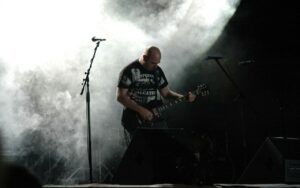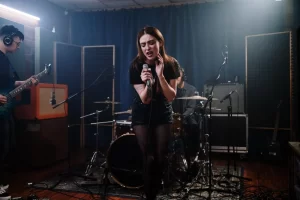Rock today consists of a familiar and well-established genre; we rarely stop to consider what it looked like as it was forming, and what its defining features are. If we pursue the question, however, the contributions of singer, songwriter, and musician Buddy Holly are impossible to overlook.
Coming of age in the early 1950s, Holly’s career took place at a time of extraordinary musical potential. The classic genres of blues and country music were beginning to explore new directions, becoming more distinctive and individually expressive. Holly and his band, the Crickets, marked a leap forward in this transition, blending a variety of current musical styles and managing to retain creative control while still being commercially successful.
Buddy Holly was a musician of fairly humble origins. Born during the Great Depression in Lubbock, Texas, in a family of musical talents, he learned the guitar and counted playing Western music among his many hobbies in high school. In an essay written when he was a teen, he says, “I have thought about making a career out of Western music if I am good enough, but I will just have to wait and see how that turns out.”
In hindsight, the statement seems quaint; Buddy went on to have a pioneering impact on the genre of rock-and-roll, becoming a key influence for big-name musicians such as Bob Dylan, the Beatles, the Rolling Stones, and the Grateful Dead.
The early years
But Holly’s transition from a small-town music enthusiast to a successful musician was not overnight. Starting in high school, he played and wrote songs with fellow classmates including Jerry Allison and Sonny Curtis, both future members of the Crickets. He also formed duos with Jack Neal and Bob Montgomery, getting gigs on the local radio and performing at events around town. Their shows took the form of a classic country and western act; Buddy and his friends had grown up listening to musicians like Hank Williams and Jimmie Rodgers, and these hallmarks would always be part of their musical roots. But their spheres were quickly expanding.
In 1955, Holly was 19, and Elvis Presley came to Lubbock. Presley’s jittery on-stage energy, his overt sexiness combined with his smooth soulful voice, was something new and must have had a decisive impact on Buddy.
Elvis’s hit “I Forgot to Remember to Forget,” became his favorite song for a time; he and his band pivoted to copy Elvis’s style. Through Pappy Dave Stone, a connection at the radio
station, Holly and his band were openers for Presley on three occasions. Along with Elvis’s influence, they were also gaining exposure to elements of rhythm and blues, tuning into distant radio channels late at night to hear musicians like Fats Domino and Lonnie Johnson. With these inspirations, Holly’s road to rock-and-roll fame had begun.
That same year, talent scout Eddie Crandall was in the audience when Holly and his band opened for Bill Haley and the Comets in October. With a little further help from Stone, Crandall was able to get the band signed to Decca Records in early 1956.

Label signings and “That’ll Be the Day”
The signing seemed like Holly’s big break; but early recordings were a disappointment, with producer Owen Bradley controlling most of the major decisions during the sessions. Decca Records had also come down on the side of “traditional” country and Western in the schism that was dividing the music industry in the late 50’s, limiting Holly from exploring new elements of rock-and-roll which were dominating the popular scene. The few singles they recorded and released made a minimal impression. Decca declined to renew Holly’s contract, and he was forced to return to Lubbock in January 1957 mostly empty-handed.
Empty-handed, perhaps, but not quite ready to give up; a month or so later, Holly took a chance to record with Norman Petty in Clovis, New Mexico. With a lineup that consisted of longtime friend Jerry Allison on drums, Joe Maudlin on bass and Niki Sullivan on rhythm guitar, he worked with Petty to craft a demo of “That’ll Be the Day”, a song he had written while with Decca. The song went on to be Holly’s first hit, peaking at spot #3 on Billboard’s pop chart and giving the newly-dubbed Crickets recognition at last.
With the single, it was clear that Holly had outgrown both his reliance on his country idols and his imitation of Elvis; “That’ll Be the Day” was unique. Buddy and the Crickets had come upon a freshness born from tight songwriting and Buddy’s jumpy but still loose vocals. This same spirit was present in the group’s later work, as they went on to develop more sophistication and innovative techniques.
The Crickets’ impact
The fact that Buddy and the Crickets wrote most of the songs they performed themselves was also new; the role of performer and songwriter were typically further apart, meaning that the creative talent was kept separate from those making the music. The combination of these elements shows in the Crickets’ discography, with composition and recording blending into a single process. This greater flexibility led to experimentation in volume and timbre changes and double-track recording, which had a great impact on later rock musicians.
Unfortunately, Holly’s career was far too short. In early 1959, newly married and short on money, Holly was persuaded to go on an international tour featuring a great number of rock musicians; while flying to perform in Iowa, Holly’s plane crashed, and he and several other musicians died. The news was tragic then, and Holly’s legacy has only grown since; the music world will always pay tribute to his multidimensional and ground-breaking body of work.


